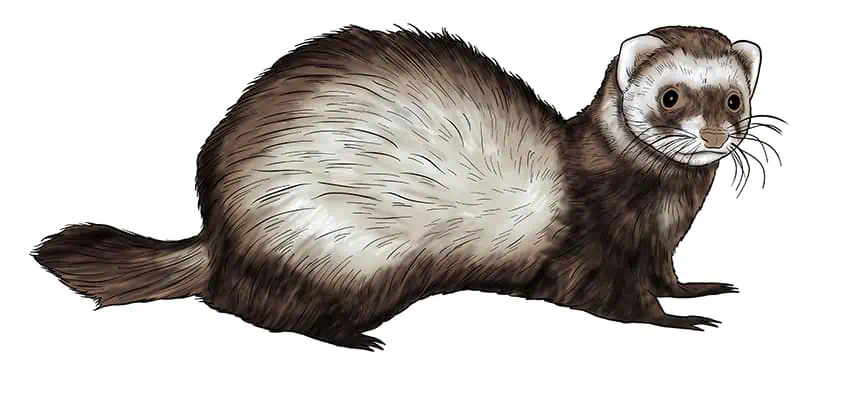How to Draw a Ferret – A Beginner’s Guide to Ferret Drawing
This post may contain affiliate links. We may earn a small commission from purchases made through them, at no additional cost to you.
In this lesson, we are going to learn how to draw a ferret. These lovely little creatures are not as common as other pets you may usually come across, but they have recently seen a rise in popularity across the globe. Known for their curiosity, smooth fur, and sparkling little eyes, these amazing animals are both fun to play with and also a great subject to draw. Their unique proportions, such as their long ears and extended bodies, can teach us about perspective and the variations in proportions that different animals display. In today’s tutorial, we will create a ferret drawing by taking you through the process easily, one step at a time.
Table of Contents
- 1 How to Draw a Ferret Step by Step
- 1.1 Step 1: Creating the Main Body
- 1.2 Step 2: Creating the Head for Your Ferret Drawing
- 1.3 Step 3: Creating a Muzzle for Your Ferret Drawing
- 1.4 Step 4: Creating Ears for Your Ferret Drawing
- 1.5 Step 5: Creating the Tail for Your Ferret Drawing
- 1.6 Step 6: Creating a Neck for Your Ferret Drawing
- 1.7 Step 7: Creating Feet for Your Ferret Drawing
- 1.8 Step 8: How to Outline the Shapes of Your Ferret Drawing
- 1.9 Step 9: Constructing the Face of Your Ferret Drawing
- 1.10 Step 10: Adding Detail to the Fur
- 1.11 Step 11: How to Add the First Layer of Color
- 1.12 Step 12: How to Add the Second Layer of Color
- 1.13 Step 13: How to add Shading to the Ferret Drawing
- 1.14 Step 14: How to Paint the Ferret’s Facial Details
- 1.15 Step 15: Final Details of Your Ferret Drawing
- 2 Frequently Asked Questions
How to Draw a Ferret Step by Step
These feisty little creatures are from the weasel family and can be found on the same branch of the family tree as otters, stoats, and badgers. Some easily observable similarities between these distant cousins are their dark fur and long body shape. Ferrets were first domesticated around 2500 years ago, where they were used for rabbit hunting due to their speed and small build.
While many animals share similar basic proportions to other animals, ferret drawing offers us lessons on the unique look and proportions of ferrets, which makes them very interesting subject matter to draw. These instructions can be applied to whichever medium you prefer to work with.
Some people prefer creating and coloring their art on tablets, while others prefer watercolors. Whichever you choose, you will soon be on your way to learning how to draw a ferret by following these easy steps.

Step 1: Creating the Main Body
You might already be aware from our previous tutorials that we always start our drawings by sketching out the entire animal with lines and simple construction shapes. By using these shapes and lines first, we can plot out the basic proportions and make sure that they are correct before moving on to the finer details. For the main part of the body of the ferret drawing, we are going to use an elongated oval shape on its side.
Keep in mind that your drawing will still need to include legs, the head, and a tail, so make sure that you place your oval as close to the center of your canvas as possible.

Step 2: Creating the Head for Your Ferret Drawing
As you will eventually see in the final version of this drawing, a ferret’s head is quite round and is also the second-largest part of your ferret drawing. So, to represent the head, we are going to use a slightly flattened circle. This circle should be placed on the right-hand side of the main oval, and slightly away from it. To keep the proportions correct in your ferret drawing, make sure that the circle used for the head is above the middle point of the big oval in the center.

Step 3: Creating a Muzzle for Your Ferret Drawing
In our drawing, the ferret is looking towards us, with a slight tilt to his head. We can see that ferrets have slightly extended faces that stick out at us, unlike some animals with flat facial features. To create the effect of a protruding muzzle, we will draw a smaller oval shape to represent the mouth and nose area. This will give our ferret’s face the perception of depth.
If you look at the example below, you can see that the smaller oval must be at the bottom of the head circle, mostly overlapping it, and positioned a bit to the right of the middle of the head’s circle.

Step 4: Creating Ears for Your Ferret Drawing
Next, we are going to use two oval shapes to represent the ears of our ferret. Although this is an easy step, you should still keep the perspective in mind when placing the ears. For the left ear, we are going to place the oval on the top left of the head, with most of the ear overlapping the head’s circle. The right ear oval should be drawn smaller than the left one and with more of a tilt to it. Be sure to place it slightly lower than the left one to help create the correct perspective.
The ferret’s head is tilted slightly towards the right-hand side of your page, so to create the right feeling of perspective, it is necessary to draw the furthest ear from us slightly smaller than the one closest to us.

Step 5: Creating the Tail for Your Ferret Drawing
Ferrets are known to have rather bushy and thick tails. To create the tail, we are going to use a very flattened oval and curve it into a slight “U” shape. Now, we will attach it to the main body by placing it at the bottom left of the oval.

Step 6: Creating a Neck for Your Ferret Drawing
We will now connect the body and the head using two lines drawn between the two, each with a slight curve. The first line will be drawn from slightly above the center of the body’s oval to the center of the head on the left. The top line should be shorter than the line we will be adding underneath it. To create the neck, we are now going to draw a line from the bottom of the oval on the right side to the muzzle circle at the bottom of the face.
The chest and shoulders will still extend out from the neck area, so be sure to draw it quite wide and not too narrow, as we will need to add the other features on this section of the ferret’s body later on.

Step 7: Creating Feet for Your Ferret Drawing
When viewed from our angle, only three of the ferret’s feet will be visible. The top half of the body is turned towards us, so both front legs will be visible, whereas there is only one leg on the side of the Ferret’s body. Let us start with the back leg. Starting at the back of the body, right in the center, draw a line that extends downwards to just below the tail. Now, tilted slightly downward, extend the previous line by drawing a line forward, then double back sharply to create the effect of a pointed back foot.
To finish the back foot, we now draw another line from the last one and let it curve slightly outwards and then back in to meet the body just before the start of the neck. The ferret’s front feet are easier to sketch. Starting at the lower part of the neck, simply draw two shapes that point away from the body. The lower foot should be larger and placed in front of the upper foot.

Step 8: How to Outline the Shapes of Your Ferret Drawing
For this next step, we are going to outline the ferret by drawing repetitive small strokes around the outer edges of the drawing. These smaller strokes are better than drawing a single, solid line as they will help to create the impression of true-to-life fur for your drawing. For certain parts of the ferret, like the ears and the feet, you can draw with smooth lines, as these areas wouldn’t be so bushy with fur.
Feel free to follow the example as closely as you like, but don’t forget to add a few bumpy areas to make your ferret feel more real and unique.

Step 9: Constructing the Face of Your Ferret Drawing
This step is probably the most time-consuming because of the level of detail. In this situation, it is best to learn patience, and you might have to repeat it a few times to get it perfect. Do not be afraid to use your eraser for mistakes – your drawings will improve with some practice.
Let us start by creating two circles and coloring them black. These will be the eyes, and to create a sense of realism, we are going to leave a small spot of white space to represent a reflection of light in their eyes. To create a sense of depth, draw a fine line around the edges of the eyes.
Now, on the muzzle, slightly right of the center, draw two nostrils with a line below the nostril to represent the mouth. For even more depth, draw a little furry line above the nose, and then from around the nose, draw some whiskers extending outwards.
Once you have completed the finer details of the face, you can go ahead and erase all the construction lines that remain.

Step 10: Adding Detail to the Fur
We are now going to add fur over the entire surface of the ferret’s body, using long curved strokes. For this step, the best advice for achieving the desired look of real fur is to follow the contours of the animal to help guide you in which directions the fur should be drawn. To make it as realistic as possible, vary the length of the hair, with the shortest strokes used around the head area and longer strokes used for the body. The longest stokes will be used for the tail.
Ferrets do not have any fur on their hands or the inner part of their ears, so those can be left smooth and free of fur.

Step 11: How to Add the First Layer of Color
To create a natural-looking ferret, we are going to apply several layers of color to our ferret drawing. The first layer should be darkish brown, and this will be the base coat of your drawing. This color should fill the entire body area. To prevent patchy coats while using watercolor, try applying your paint as fast as possible.

Step 12: How to Add the Second Layer of Color
Now we will add the second coat to the ferret drawing, and this time we will be adding a layer of white. Using a soft, small brush, we will now apply a layer of white color to the body of the ferret, as well as his neck and face area. Now, add some finishing details such as facial markings and the coloring of the inner ears. The nose and eyes of your ferret drawing should remain brown, however, but softly outlined in a circle of white.

Step 13: How to add Shading to the Ferret Drawing
Now we will use black shading to help create a realistic look in this stage of the coloring process. Using black paint, very lightly shade the areas on the edges of the brown fur darker. Concentrate on shading around the outer edge of the body, around the brown parts of the ferret’s face, and on the bottom half of the body.
To help make the color layers feel more textured and natural, be sure to follow the hairline of the ferret’s coat when shading.

Step 14: How to Paint the Ferret’s Facial Details
We will now add more detail to certain aspects of the ferret’s face by using a layer of pink. Using a small paintbrush, fill in the spaces inside of the ferret’s ears as well as its nose. Then add a stripe of pink around the eyes, and finally, use white once again to touch up the reflective part of the eye.

Step 15: Final Details of Your Ferret Drawing
Although this step can be skipped if you are already happy with the outcome, you can also choose to take it to the next level by following these easy steps. First off, erase the outline of the ferret’s body. This is easily done if using a tablet or another electronic device. If you are using paint as your medium, then use the correct color for each area and re-touch up and add new lines of fur over where the outline used to be.

Congratulations! You now know how to draw a ferret step by step! If you aren’t entirely happy with the outcome of your ferret drawing, just remember that practice makes perfect. Don’t forget to have fun!
Frequently Asked Questions
Can This Tutorial Also Be Followed if I Am Using Watercolor Paint?
You can use any medium that you prefer to create your ferret drawing, from digital to paint. However, if you are using watercolor, you will need to work faster, as it dries much faster than other paints.
What Is the Most Difficult Aspect of Drawing a Ferret?
The most challenging aspect of your ferret drawing will be getting the proportions correct. This makes ferret drawing a particularly good subject to help improve your compositions through a better understanding of proportionality.
Learn more about Israel Benloulou and about us.









